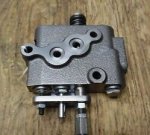Thats some poor advice. Sectionsl valves are no different than monoblock and require a power beyond mechanism that isolates the neutral core from the tank core when being used for high pressure carryover. This is not a structural strength issue. There are a multitude of issues but two that leap to mind:You're right. Your tractor is missing a whole section of gearbox that is visible in the other pic (probably another gear splitter hi/lo type of thing) and your 3pt pressure feed line has no hydraulic 'block' there.
The good news is i don't think your loader valve NEEDS a separate 'power beyond' port to be put in series with your 3pt, because it is a 'sectional' valve for which power beyond would probably split off at the 'outlet' housing, meaning all the passages of everything in between were designed to withstand high pressure. In fact, it seems likely your inlet and outlet sections on that valve are identical other than having their ports drilled in from opposite ends. So that entire valve assembly can handle high pressure. Therefore you can just power your 3pt from the outlet of your loader valve, and while using the 3pt your loader valve will have pressure on both its inlets and outlets and will not work until you release the 3pt handle, but it won't blow up either. The issue with that approach is that you would still need the pressure relief valve between the pump and loader valve since the loader valve does not have its own pressure relief.
It does seem odd to me as well that you have a dual-acting valve with only one work port connected to anything and the other blocked, but this may make sense if your loader lift cylinders are single acting and do not have 'power down', or in other words only drop by gravity. A picture of the entire loader would help. Regarding the comment about 'deadheading' with that blocked port, im assuming the long screw coming out of the bottom of that valve section is and adjustable stopper that (if set correctly) would prevent you from moving the spool to the position that would deadhead the pump against the blocked port.
If you are willing to do compression fittings on your pressure feed line, you could install fittings into the pressure line in the same area that the hydraulic block exists on the other tractor, and your existing hoses may even reach there and not need to be swapped out for different hoses. You could potentially even package the pressure relief valve into this area somehow. Replacing the loader valve with one with an internal pressure relief is still an option.
If you are not willing to do compression fittings on your pressure feed line, then a 'fitting block' between the pump outlet and the pressure line would probably be the next easiest.
- The seals on the ends of the spools see tank core pressure and are not designed to handle much more than 500 PSI. Start subjecting them to 2000+ PSI neutral core pressure and you are begging for seal failures and leaks.
- Any inlet or port relief valves unload to tank. If tank pressure is the same as neutral port pressure they cannot do their job.
Dan



